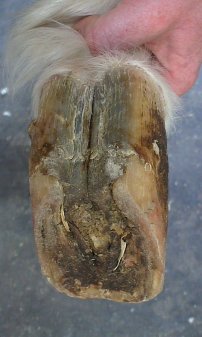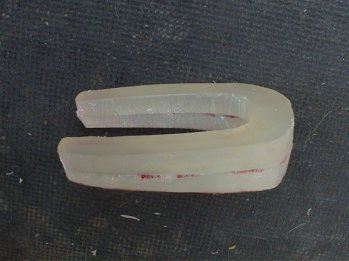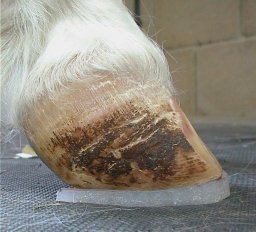|
TOE
WEDGE TESTING FOR "TENDON CONTRACTURE"
i.e.
deep digital flexor muscle contracture
| Some chronic
founder cases grow an excessive amount of heel horn due to a shortening of the
distance between the origin and insertion of the deep digital flexor tendon muscle.
This appears to happen, usually at the time of acute founder, in response to foot
pain.
It means that you cannot
correct an upright or malaligned phalangeal column by lowering the heels, as you
would do in an unaffected case.
Lowering the heels on cases
of contracture makes them very lame, they cannot get their heels down to bear
weight and must hobble about on their toes. Some cases will lie down if their
heels are reduced.
|
 |
| To avoid such
a situation, which is painful for the horse and embarassing for the operator,
I suggest you perform a toe wedge test before lowering the heels.
Obtain a few wedges about
5 or 10 degrees each which are horse shoe shaped, so that they can be fitted under
the toe of the foot without pressing on the sole.
|
 |
Place wedges
under the toe of the affected foot. ( The height of the wedges should eventually
be the same as the amount of heel you wish to remove ).
|
 |
| Have
the contralateral limb lifted so the horse stands on the leg with the wedge under
its toe. See if it becomes more uncomfortable compared to making the animal load
the limb without the wedge under the toe. Feel the tension in the deep flexor
tendon when the limb is loaded.
If the animal is less comfortable
with the wedge under the toe and the loaded tendon becomes very tight then you
probably have a case of contracture. If you drop the heels on this case, expect
it to be worse.
Your alternatives are 1;
leave the heels higher than you would like but high enough if the horse is reasonably
comfortable or 2; resect the inferior check ligament or 3; divide the deep digital
flexor tendon. Which of these you chose is a matter of clinical judgement, if
in doubt cut the tendon.
|
 |
|
